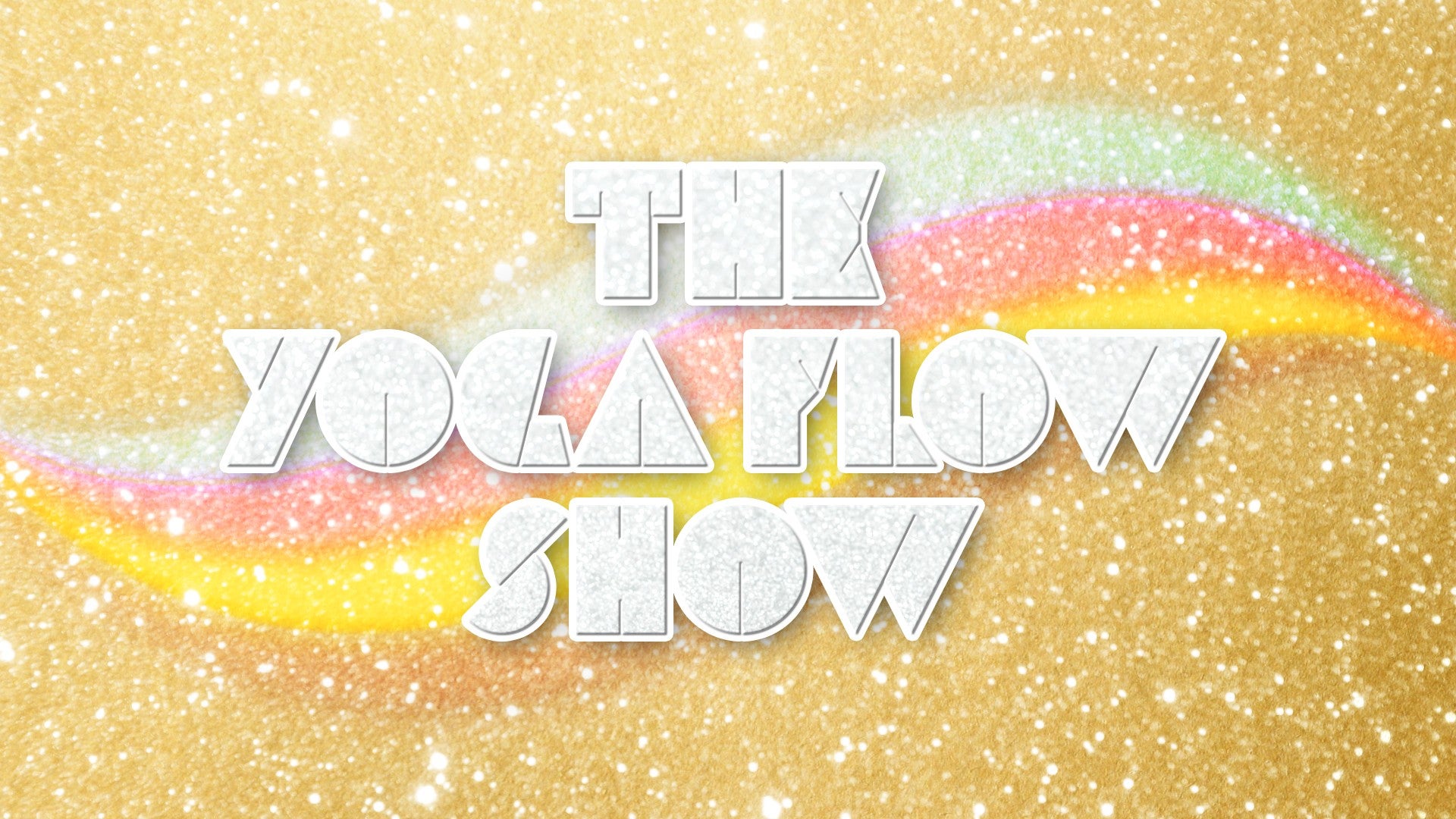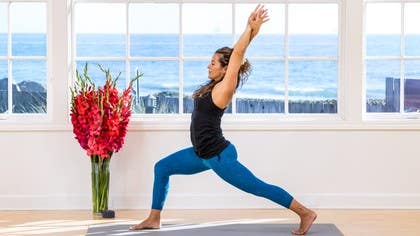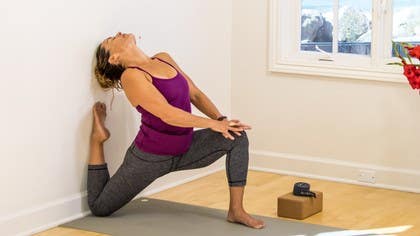Description
About This Video
Transcript
Read Full Transcript
(ocean waves crashing) Greetings tribe. Namaste. It's great to see you again. So, for this practice we'll be tracing some of the pathways towards dropping back into backbends to opening up to a fearless heart. And the entire practice will be working with the wall so if you can set up your mat somewhere near an open wall space, that would be really helpful.
And also, if you have a block and a strap handy, have it handy and also, let's start by just measuring the length of your legs from the wall. And we'll use this as a marker later during our flow. So a really simple way to do that is just to sit with your back against the wall and whatever line your heels hit, just place your block right in that line. And let's go ahead and begin. So we'll start at the top of the mat together.
Place your feet hips width apart and as you inhale just open your heart, your fingertips towards the sky. Take a deep breath in. And as you exhale, draw your hands back to the heart in a Lotus Mudra. So the heels of the hands touch, pinky fingers and thumbs touch. And inhale, open back up.
I'm just setting the tone for your practice. And exhale. Draw your energy down into your heart. And inhale. Feel the heart lifting over the architecture of the spine.
And as you exhale, just draw that wonderful, fresh prana back into the heart center. Once more. Inhale to expand. And exhale back to your center. And moving into Chandra Namaskar as you inhale reach forward and up and, again, feel the heart lift up and over the spine.
As you exhale, sweep your hands forward and down into an easy forward fold. Step the left foot back to a low lunge and inhale, sweep forward and up. Exhale, release your hands to the mat, step back to Downward Dog. And on an inhale glide forward to plank. And then Chandra Namaskar we always take a Lunar Vinyasa.
So set the knees down and then bring the chest and hips down to the Earth. And inhale to a Low Cobra, reach back through the toes, forward through the heart, and exhale back through the hands and knees to Downward Facing Dog. Step the left foot forward and lower the back knee and inhale to reach forward and up. As you exhale push off the back foot through a little standing split to your forward fold. And inhale, reach forward and up.
Exhale, hands to the heart. And that was half of one full cycle. Let's take the other half. Inhale to reach up. And exhale, empty the lungs, empty the mind.
Step the right foot back, lower the knee, and on an inhale start to open up into a little bit of a backbend. And then exhale folding back to Downward Facing Dog. Shifting forward and exhale, lower the knees, followed by chest and hips. And inhale, open the heart. Exhale, back to your Downward Dog.
I'm just creating an easy flowing pattern. Step the right foot forward, lower the back knee. Inhale to rise. And this is a variation of Chandra Namaskar. Push off the back foot, lift the leg, and then bring the feet together.
Inhale to reach forward and up. And exhale, hands to the heart center. Let's take one more full round. Inhaling to reach, lifting through the side waist. Exhale, forward fold.
Left foot steps back, lower the knee, and inhale to lift. Exhale to the Downward Dog and start to feel just the flow and lilt of your breath as you shift forward. And lower down and then rise back up again. And exhale to press back. Left foot steps directly through.
Inhale to rise. Exhale, push off the back foot, lift the back leg and let the crown of the head drop down to the Earth. Right foot meets the left. Inhale, reach forward and up. And exhale, hands to the heart.
And one more half of the cycle. Inhaling. Exhaling. Right foot steps back. Inhale, feel the fluid nature of your body, of your breath.
And exhale, shifting back, riding forward on your inhale, riding the breath. And exhale to lower. Inhale, open your heart. Exhale, folding back. Right foot steps forward, lower the back knee and inhale to rise.
Exhale, push off the back foot, let the crown of the head tip down as the left leg lifts. And then feet come to meet at the top of the mat. Inhaling to rise. Exhale, hands to the heart. And take a nice wide step to your right, open up from the heart and then lace the fingers behind your back.
Let's lift the chest. And if your soldiers feel tight, you can always take your strap and hold it with your palms facing forward. This will create a little space in the shoulders. And as you exhale, melt into your forward fold. And let your knuckles just dip overhead.
Crown of the head relaxes. Shoulders can lift up away from the base of the skull. You can also lift the quadriceps as you hang down here. Take in a deep cycle of breath. As you exhale, drop in a little deeper.
And one more cycle of breath. And releasing your hands, bring your hands underneath your shoulders, lift your chest, and then exhale, hands come to your hips. Inhale to stand, reach the arms out and up, touch your palms. And then open up the right foot, bend your knee, and you can slide the left heel a little further back coming into your Rear Virabhadrasna II. And let's take a variation here with our arms.
Bring your arms into Garudasana arms, wrap them like jungle vines and spread the shoulder blades wide to lift the elbows up away from the chest. And then keeping your base steady, we'll just start to find a little movement through the upper body and the hips. As you inhale, lean back like you're in a Reverse Warrior. Exhale, let your forearms come down towards the Earth, the hips drop back and then just gliding forward towards your front foot. As you come up and over the horizon of the hips they come back to neutral.
And then just take that again as you exhale. Release the hips back. And as you inhale come up and over the horizon of the hips. And just once more, just massaging the hips. A little bit of work in the base.
And exhale to come back up to center. Open up your arms wide. Inhale, reverse your warrior and look down towards your back foot, releasing the side of your neck. Full breath in here. And exhale slowly, come down, hands towards the wall and let's step back to plank.
And maybe the right leg is streaming. Maybe roll to the outer edge of your left foot and come down into a Parsva Chaturanga. And then square off the feet and hips and rise, Urdhva Mukha Svanasana. Exhale to Downward Dog. So you're welcome to hang out right here for a few breaths.
If you'd like to start to work with just lifting your energy up towards the wall, you can take your hands a little closer to the wall, maybe about six inches from the wall. Shorten the stance and just nice and light, start to hop the hips and heels over the shoulders, keeping your gaze towards the baseboard. Then just kind of experimenting with a little bit of lightness, with exchanging weight from your feet to your hands. And then go ahead and take the feet towards the back of the mat. Lift your heart, crown of the head towards the wall.
And then exhale, release. Separate your feet about hips width apart here and on an inhale rise all the way up to standing. As you exhale, bring your hands in Lotus Mudra to your heart and lift your heart up and over your spine. Reach back up to the sky, inhale. And exhale, up and over the support of the back body.
Just looking up, looking back slightly. Inhale. And starting to trace that pathway towards dropping back. Inhale to reach up. And exhale, release your hands to your heart.
Step nice and wide to Prasarita. And let's add a little Gomukhasana shoulder opener. So, right hand can reach behind the nape of the neck, take your elbow and draw it behind your head. And then release your left hand down. You can link fingertips if it feels a little far away.
Grab your strap and dangle it down your back. And on an inhale, lift through your chest. As you exhale, forward fold. Hanging out here for a few breaths. As you breathe, kind of spread the back of the heart into your hands, open up the back ribs.
And as you exhale, release into gravity. Inhale to rise, come all the way back up. And let's exhale, sweep your arms to the second side. Left hand reaches to the nape of the neck. Grab the tip of the elbow and just opening the shoulder here.
And sometimes I even like to stay right here and just keep the hand on the tip of the elbow, then fold forward, it's your choice. You can take your right hand behind your back and link up with a strap, your fingers, your hair, whatever you can grab and then come into your forward fold. And really breathing into the back of the heart, spreading wide through the lungs. And just feeling that internal tone and quality of relaxation even though the body's working a little bit, just staying very relaxed inside, just cruising. On an inhale, slowly come back up.
And as you exhale, release your arms. Circle the arms wide. Catch a little energy and as you exhale turn the left foot open, slide the right foot back, coming into your Warrior II, Virabhadrasna II. And we'll take that same variation here, wrapping your arms in Garudasana, opening up the back of shoulders, and then just lean back, a little side bend as you inhale. And then as you exhale, the torso drops down, the hips drop back, circle forward, up and over the hips, inhaling the lean back.
Exhale, shift the hips back. Light upon the Earth. And then up and over. And exhale digging down and coming back up. Then open up your arms wide into your Warrior II.
Reverse your Warrior on an inhale, look at the back foot and try to create as much space as you can through your side waist. Deep inhale to lengthen. As you exhale, take your hands to the Earth. Step back to plank and maybe let that left leg stream. Maybe roll to the edge of the foot if you like, and lower, Parsva Chaturanga.
Inhale, open your heart. And exhale, Downward Dog. Last time we were here we were facing the wall and we were working with hopping the hips and heals over the shoulders. And now we have the opportunity to work with a little bit of fearlessness. And shift your shoulders over your hands and keep your gaze forward towards the top of a triangle.
And rather than thinking about kicking to the wall, just focus on kicking up to the sky, one leg's gonna reach up. One leg's gonna reach up. And take a couple rounds, a couple breaths, on the left leg. And then the right leg. And there's always that feeling of like, what if I go over, what if I lose my balance, and if that happens, if you start to feel like you're going over, just walk it out like you would in a cartwheel.
You can walk it out to either side. If you have a beautiful bouquet of flowers next to you, you just want to be mindful. But keep the hands and the gaze fixed and allow your legs to just reach straight up to the sky. Exhaling as you kick up. And then step to the front of the mat.
Lift your heart. Exhale, forward fall. Shake out the head a couple of times yes. And then no. And back to yes.
And catch it on the upswing. Inhale, rise. Exhale, hands to your heart. So let's continue just working with a little bit of upside down time. And, again, when we work with handstand and inversions, we do so for many reasons and, in particular, is to kind of just like brush the edge of when there's a little bit of like fearfulness because it's pretty common that we feel like, oh, I'm scared, I might fall.
But part of having that fearless heart is interacting with that and being brave, as I tell my kids. So, we'll continue working with a little bit of inversions at the wall and really as a vehicle to open the shoulders for dropping back into backbends. So there's a purpose behind it. So if you come into inside of wherever you measured the length of your legs and just bring your hands down to that same line that your block is on or whatever landmark you used. And then drop the head, look back towards the wall, and take your feet to the wall and we'll come up into L pose.
It's basically a slightly inverted Downward Dog and one of the common mistakes here when I ask students to come into this is that they either shift the shoulders forward, which is kind of hell on wheels, shift your chest and shoulders back, or sometimes people take the feet up too high and end up in a kind of a strange inverted plank. But keep your body at a right angle. So the legs are really parallel to the Earth and we're building strength and stability through the upper body, opening the chest towards the wall, and working with being upside down with a support system. Slowly come down to your knees and take a moment here and just give your wrists a little bit of love. And keep in mind that the shape that we were just in, L pose, is actually a little harder than handstand.
It's kind of like the training wheels for handstand with a little extra added oomph. So, once we actually take a leg up to the sky, which we'll do now, it's gonna feel a lot lighter and a lot freer. So bring your hands back to that same line you were on, shoulders stay right over the wrists, you can drop your head here. And then take your left foot to the wall, lift up and thread the right leg straight up to the sky. Internally rotate your top leg and just feel that wonderful line of energy, down rooting through the ground, up through the top foot.
Exhale, slowly come back down to your knees. Give the wrists a little love. Pull them into flection, extension. And we'll go to the second side. Hands line up with your block, lift your hips, deep breath in here.
And as you exhale this time, right foot to the wall, extend the left foot straight up, lengthening through your hands, through the feet, that rooting energy and rising energy working together to create stability. Take one more breath and as you exhale, slowly come down. And this time, step the right foot slightly forward and take the shin, the left shin, to the wall and slowly slide all the way down to the mat, coming up into a little Kneeling Warrior. A lot of students have a little sensitivity in the knee here and so if you're feeling that you can always place a folded blanket or a bolster underneath the back knee. If this is too deep for you, simply scoot away from the wall and come into more of a released lunge.
But just working with a little bit of quadricep opening here which serves our back bending. So we're taking pieces of the backbend and prepping the body for drop backs. We just worked with opening the shoulders in hand stand and now we're opening the quads. Let your hips release forward and down and lift through your heart. Let's take a couple of breaths here.
One more deep breath in. Really fill up the lungs, fill up your fearless heart. As you exhale, let your hips melt forward and down, which is gonna slightly make it feel a little saltier. And now start to lift your heart up and over the support of your spine and let the back of your head have a little conversation with your back foot. Then slowly release, take your hands to the mat.
Let your back shin pivot to the right, curl your toe under and press into your forward fold. And just hang out here for a moment. You can grab on to your opposite elbows. Relax your head and neck. Releasing your hands, lift your chest.
This time step the right shin back and slowly lower down. Any variation that you worked with on side one you can work with here on side two. And many of us are right-side dominant so the right leg always feels quite different than the left leg. It might feel a little tighter but just give it a little more breath in the form of love, love in the form of breath, and hang out with it. One of my teachers that I've been working with for several years, Max Strom, talks about how we store different issues in our tissues and, in particular, in the quadriceps is where we tend to store anger.
So if you're feeling a little tightening in here, see if you can just relax into it and be comfortable in a place that might not be that comfortable. Just for a couple of breaths. Inhale. And exhale. Deep breath in.
As you exhale, let your hips dip forward and down. And then climb your heart up and over the back body, almost like there's a waterfall behind you and you're dipping your head into the waterfall. And then slowly release. Ahh! Let the back foot pivot to the left, tuck your toes under and press into your forward fold. Inhale and lift your heart.
Come all the way up to standing. As you exhale, draw the hands to Lotus, to your heart. Look back towards the wall. There it is. Inhale, reach to the sky.
And once again as you exhale, just looking back to the support of the wall. Once more, inhale. And exhale. Draw the hands to the heart. So, let's take one more preparation before we drop back and we'll work with kicking up to Pincha Mayurasana at the wall.
And we kind of were paving the ways for this in some previous practices so if you want to use your strap and your block, it just adds a little bit of support. We can place the block at the wall and place your fingertips at the block so that your hands don't pivot in. And you can take your strap, I pre-measured mine, and place it right above the elbows so that we have this nice base for Pincha Mayurasana, right? And go ahead and take your hands, your fingertips, to the block, curl the toes under and lift your hips. And our gaze is forward, the head is not down on the mat.
And we'll step the right foot in and the same emphasis when you're kicking up towards handstand is kicking straight up to the sky. And even if you're here and you're working on kicking up and opening the hamstrings, there's still medicine inside of that. So keep working with kicking, whether it be to your balance, whether it be halfway up, whether it be to the wall, wherever you're at, just working with a little inversion here from feet to form. So when you come down, or rest in between, make sure you go to the opposite side so it's a little equal opportunity system from the right leg to the left leg. And, again, make your emphasis to kick up, rather than kick to the wall so your body starts to learn where balance is right from the get-go.
Breathing is always a good idea. Ha ha ha. And talking when you're upside down is exceptionally hard sometimes. But, hey, it gets us breathing. Take a little rest in Child's Pose and let your forehead rest on your strap.
And then slowly roll up your spine. And let's set our props to one side and we'll work with dropping back a little bit. And we'll start from our knees and then from our feet. What I love about dropping back from the knees is that it really teaches and informs the body of what areas need to be recruited, so to speak, to support the spine in a drop back. And it's a lot of work in the legs, it's a lot of activation in the legs.
So you can take the front edge of your mat or the back of your mat, depending on your orientation, and fold it back so you get double the padding and bring your knees right up onto that double-padded mat. And take your hands to your hips here, drop the tailbone down, and lift your heart, and bring your hands in front of you. Just a light clasping of the hands or even open palms is a little nicer. And hinge back, one long line from your knees to your crown. And we'll just do this a few times.
What's kind of interesting here, you'll feel it right away as you hinge back, is that the quadriceps are lengthening as they're bearing the weight of your body. It's called an ecentric contraction and it's a really wonderful way to build strength in any of your muscle groups. Is holding the length of the spine, the length of the entire shape as your muscles are getting longer rather than shorter. So from here, bring your hands to your heart and just add a backbend in the upper part of the spine. The lower part of the spine in your base is gonna stay connected.
Inhale to lift your heart, hinging back, looking towards the wall. And then exhale, come back up. Inhale to lift your heart, hinging back. Exhale to come up. And we can even add one arm reaching up and back to touch the wall.
And exhale and you'll feel you have so much power in your legs here that hopefully you're feeling very supported. And diving up and over into, maybe both arms, into the waterfall. And if you do touch the wall, push off of it to come back up. Take your hands to your mat, unfold it, and then come into your forward fold. A little counter pose here.
Deep inhale. As you exhale, just relax down and just kind of notice how you feel. Every single one of these asanas, every single one of these flows has a medicine inside of it. When we work with inversions and backbends, they have this wonderful quality in helping us to become a little more courageous, a little more fearless, but also just to open our hearts and to be vulnerable. So let's go ahead and soften the knees and roll up the spine.
And come to standing. Circle the arms out and up. And exhale, bring your hands to your heart. Ahh! To your fearless heart! So let's work on dropping back from the feet a little bit. Very similar to what you just did from your knees.
Reach back so you're about an arms distance from the wall. And as soon as we start to drop back you'll figure out if you need to adjust further away or closer to the wall. But about an arms distance is a good place to start. Place your feet a little wider than hips width apart. And, of course, when we're in weo we do want to keep our feet parallel.
But when we're in the process of learning to drop back, you'll probably notice your feet will slightly turn out in order to navigate the movement of the pelvis over the femur bones. Totally normal but just know that we are going towards keeping our feet neutral or bringing them back to neutral once we go up and over. So, there's a little room for play there but eventually we go back to neutral. Let's inhale, reach to the sky, lift your heart up and over your spine, look back. And then exhale, hands to the heart.
And we'll do this a couple of times. As you inhale to go up and over you might go a little further and actually touch the wall. And push off the wall to bring the hands to the heart. And inhale with your wonderfully open shoulders, shifting back, and exhale. And this might be where you stay today, working with that trusting of the support of the spine.
Or you might decide you want to go a little further down and I can tell for me, I need to just give myself a little more space away from the wall. So we'll inhale to reach up and over. And as you exhale you can start to walk down the wall. Maybe walk back up. And it's really yours to decide the degree of how far you'd like to go.
Maybe down a little further, looking for the mat. And we're just tracing these pathways and maybe, if you're feeling pretty comfortable, you walk all the way down into your Urdhva Dahnurasana. And you can adjust your feet to parallel. Press your heart towards the wall. And enjoy Salvuras.
Eyes hugging the midline, heart open, arms strong. And today, let's just come down onto backs. Tuck the chin to the chest, roll down your spine, and release your feet, your knees into your chest. Ahh. Feeling a bit of a sense of accomplishment here.
And then rocking up. Let's turn around and take our legs up the wall. So I'll just set my block and strap to one side and shift around. The easiest way to get the legs up the wall is to scoot your hips as close as you can to it first and then a little tuck and roll to slide your legs up the wall. And just enjoy a moment or two here of grounding down and shifting, shifting gears.
Coming down the back side of the wave. And just kind of feeling how those pathways resonate inside your body. Notice how your physical body feels. As you take another breath, notice how your energetic body feels. The next breath is noticing quality of the mind.
Quality of the heart. Then let's take a simple twist here. Just bend your knees, let your feet slide down the wall. And rock all the way over onto your left hip and do let your knees and your feet come to the floor, opening the chest. Turning your head in opposition away from the knees so you have a complete twist from the sacrum all the way to the crown.
Deep breath in. Exhale through the mouth. Then take your knees up and over, draw the naval in to support the low back and slide it over to the other side. And feet, hips, knees, coming down all the way to the Earth and turn your head the opposite direction. Take a deep breath into your heart.
To your belly. Exhale, relaxing down. And then as you're ready, slowly come back to the center. Draw the naval in to come back to the center and let's come into a little Baddha Konasana here. You can slide the knees down towards your hips, soles of the feet open towards your heart.
And I like to press my knees towards the wall here and just get a little bit of traction and sometimes even walk your hands towards the root of your thighs and press down and just kind of experiment a little bit with what feels good to you. Let your shoulders relax. And chest, if your chest tends to lift up, breathe into that and then as you exhale, just soften the heart center down. Let's try to get as much of your spine, as much of your upper spine in contact with the Earth as possible. Deep breath into the side ribs.
As you exhale, draw the naval center in, and then take in the knees together. Slide the feet up the wall just a touch and we'll come up and do a supported shoulder stand. So you can lift your hips up towards the sky. Make sure your head's free of any, anything in the way. If you need to move a hairdo, and then bring your hands to your hips, scoot your elbows in underneath you, and just stack your shoulders as best you can.
And we can use, again, use the feet to press down towards the baseboards and that'll help traction the hips up over the shoulders. I have tight shoulders here so this really helps me to line up my shoulder stand towards somewhat neutral. And you can take one leg to the sky and you're welcome to hang out there with one leg to the sky. Or you can take both legs to the sky. Even if you prefer to simply keep your feet on the wall, you're still in shoulder stand, you're in the essence of shoulder stand completely with your feet on the wall.
So this is a really nice option if you find Sarvangasana somewhat out of reach. It really makes it practical to use the wall here. Let's take a couple more breaths, wherever you're at. And then when you're ready, simply fold your legs up and over into Halasana, it's a plow pose. Really great counter pose for the back bending practice that we just came out of.
Release your hands to the wall and then one leg at a time reach your left leg up, bend your knee, catch the weight of your body into the wall and just slowly roll down releasing your legs up the wall, releasing your arms over your head and closing your eyes. You're welcome to stay here for Shavasana. If you prefer to press away from the wall and spread out on the floor in a more classical Shavasana, feel free to do so. But let's hang out here together for five good breaths. Let your last breath here be the deepest one.
Exhale completely through the mouth. Then draw the knees down toward your heart. Roll off onto one side. It doesn't matter which side. Just roll off.
Press yourself up and let's just take a comfortable seat with our back against the support of the wall. So you can just shift on back. And once you feel yourself set up comfortably here on your throne, just bring your hands to your heart back into, this is one of my favorite mudras, Lotus Mudra. And you can let the tips of the thumbs just touch the heart. And that open flower symbolizes so much.
We know that lotus grow out of the deep, dark mud of a pond and up to the surface to the light. It's a great metaphor for life, really, any circumstances, any part of the cycle that you're on. We're always in a cycle of beginning, igniting something, sustaining, carrying through, and then dissolving. Dissolution. And so whether you're down in the dissolution, in the compost phase of something, or growing, or up at the light, it's really wonderful just to remember that it's this continuous cycle.
Right. And every part of it has blessings. Blessings that are coming in to your lotus as well as all your wonderful, unique blessings that you can share from your fearless heart. Your fearless heart. So just take a moment here and meditate upon just a few of your own unique qualities that you have to share.
And then just feeling gratitude for all the blessings that you already have. All the blessings that are coming your way, feeling gratitude. And bringing the fingertips to touch. Holding those blessings inside the palms of your hands. And thank you so much for sharing your presence and your practice with me today.
Namaste. Have a wonderful day.
The Yoga Flow Show: Shelley Williams
Comments
You need to be a subscriber to post a comment.
Please Log In or Create an Account to start your free trial.



















